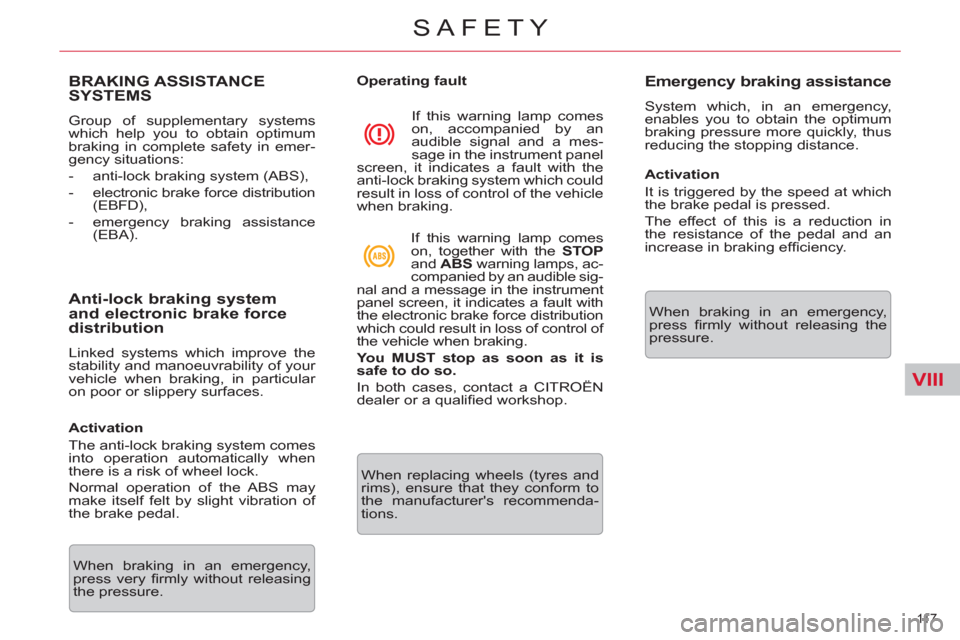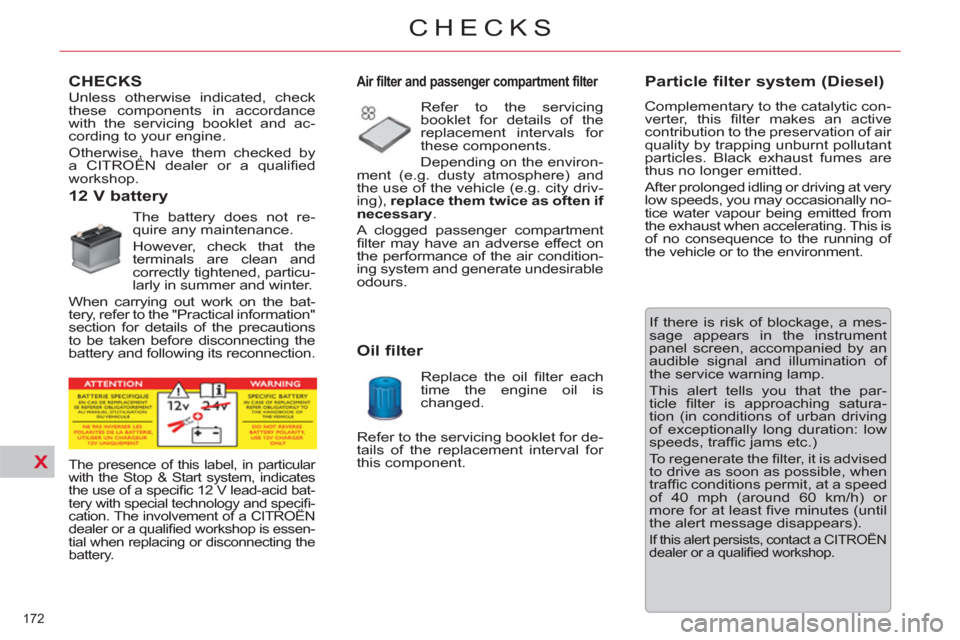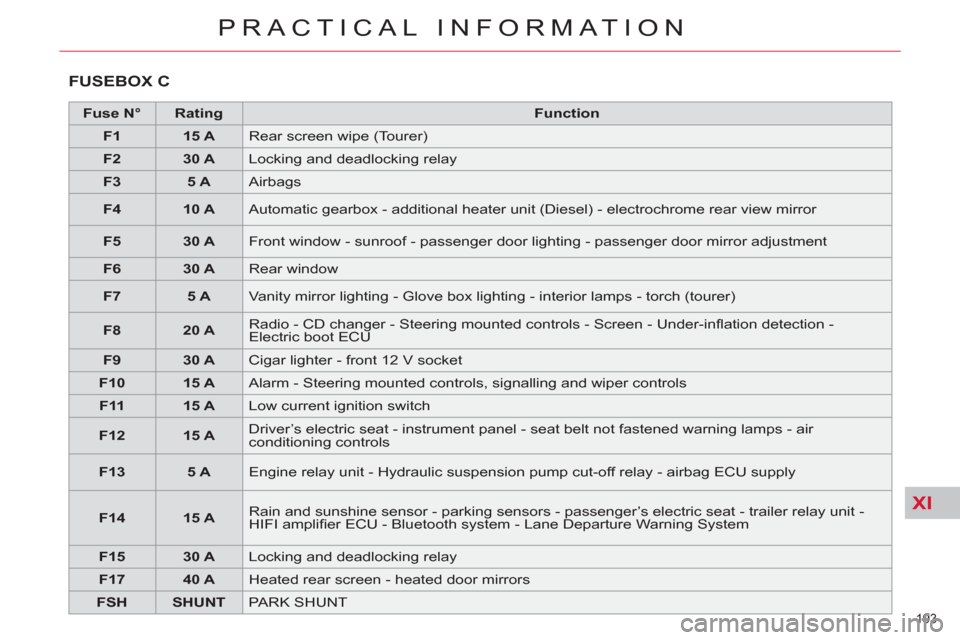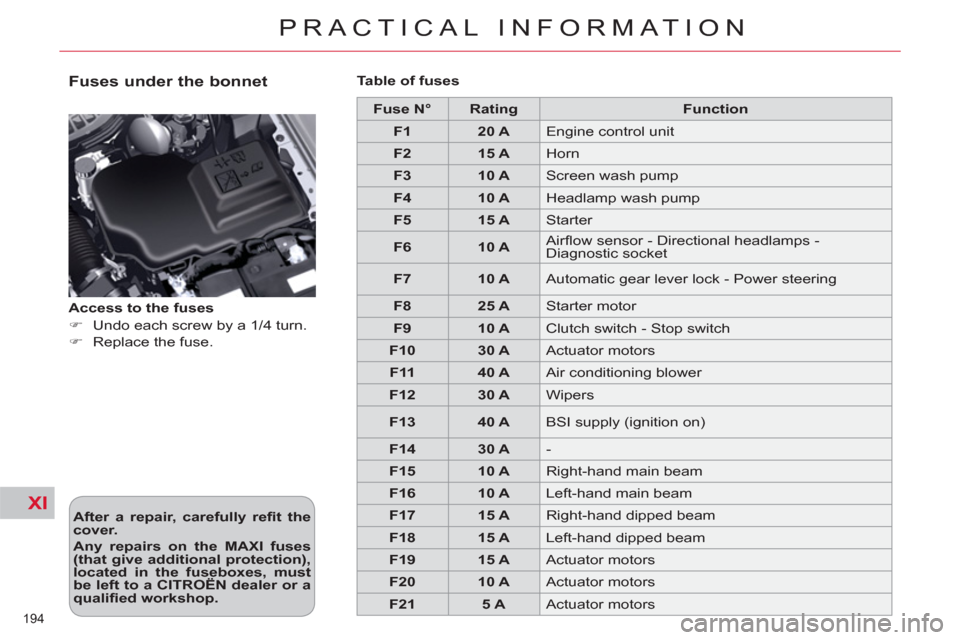lock Citroen C5 2012 (RD/TD) / 2.G Service Manual
[x] Cancel search | Manufacturer: CITROEN, Model Year: 2012, Model line: C5, Model: Citroen C5 2012 (RD/TD) / 2.GPages: 316, PDF Size: 9.75 MB
Page 119 of 316

VIII
11 7
SAFETY
BRAKING ASSISTANCE
SYSTEMS
Group of supplementary systems
which help you to obtain optimum
braking in complete safety in emer-
gency situations:
- anti-lock braking system (ABS),
- electronic brake force distribution
(EBFD),
- emergency braking assistance
(EBA).
Anti-lock braking system
and electronic brake force
distribution
Linked systems which improve the
stability and manoeuvrability of your
vehicle when braking, in particular
on poor or slippery surfaces.
Activation
The anti-lock braking system comes
into operation automatically when
there is a risk of wheel lock.
Normal operation of the ABS may
make itself felt by slight vibration of
the brake pedal.
Operating fault
When braking in an emergency,
press very fi rmly without releasing
the pressure. If this warning lamp comes
on, accompanied by an
audible signal and a mes-
sage in the instrument panel
screen, it indicates a fault with the
anti-lock braking system which could
result in loss of control of the vehicle
when braking.
If this warning lamp comes
on, together with the STOP
and ABS
warning lamps, ac-
companied by an audible sig-
nal and a message in the instrument
panel screen, it indicates a fault with
the electronic brake force distribution
which could result in loss of control of
the vehicle when braking.
You MUST stop as soon as it is
safe to do so.
In both cases, contact a CITROËN
dealer or a qualifi ed workshop.
When replacing wheels (tyres and
rims), ensure that they conform to
the manufacturer's recommenda-
tions.
Emergency braking assistance
System which, in an emergency,
enables you to obtain the optimum
braking pressure more quickly, thus
reducing the stopping distance.
Activation
It is triggered by the speed at which
the brake pedal is pressed.
The effect of this is a reduction in
the resistance of the pedal and an
increase in braking effi ciency.
When braking in an emergency,
press fi rmly without releasing the
pressure.
Page 121 of 316

VIII
11 9
SAFETY
SEAT BELTS
Front seat belts
The front seat belts are fi tted with
a pretensioning system and force
limiter.
This system improves safety in the
front seats in the event of a front
impact.
Depending on the seriousness of the
impact, the pretensioning system in-
stantly tightens the seat belt against
the body of the occupant.
Fastening
�)
Pull the belt down in front of you
in a steady movement, making
sure that it does not become
twisted.
�)
Press the fastening into its buckle.
�)
Check that it is properly secured
and that the automatic locking
mechanism operates correctly
by pulling sharply on the belt
strap.
�)
The lap strap should be posi-
tioned as low down as possible
in the lap and as tight as pos-
sible.
�)
The diagonal strap should be
positioned across the chest and
away from the neck.
Each belt has a reel that adjusts its
length automatically to the girth of
the seat occupant.
The pretensioning seat belts are ac-
tive when the ignition is on.
The force limiter reduces the pres-
sure of the seat belt against the
chest of the occupant, so increasing
his protection.
Reactivation
Below 30 mph (50 km/h), press the
"ESP OFF"
button to reactivate
these systems.
They are reactivated automatically
above 30 mph (50 km/h) or every
time the ignition is switched off.
Operating fault
If this warning lamp comes
on, accompanied by an
audible signal and a mes-
sage in the instrument panel
screen, this indicates a fault with
these systems.
Have it checked by a CITROËN
dealer or a qualifi ed workshop.
The ESP/ASR systems offer ex-
ceptional safety in normal driving,
but this should not encourage the
driver to take extra risks or drive at
high speed.
The correct operation of these sys-
tems depends on observation of
the manufacturer's recommenda-
tions regarding the wheels (tyres
and rims), the braking components,
the electronic components and ob-
servation of the assembly and re-
pair procedures used by CITROËN
dealers.
After an impact, have these systems
checked by a CITROËN dealer or a
qualifi ed workshop.
Page 123 of 316

VIII
121
SAFETY
The driver must ensure that passen-
gers use the seat belts correctly and
that they are all restrained securely
before setting off.
Wherever you are seated in the ve-
hicle, always fasten your seat belt,
even for short journeys.
Do not interchange the seat belt
buckles as they will not fulfi l their
role fully.
The seat belts are fi tted with an in-
ertia reel permitting automatic ad-
justment of the length of the strap
to your size. The seat belt is stowed
automatically when not in use.
Before and after use, ensure that the
seat belt is reeled in correctly.
The lower part of the strap must be
positioned as low as possible on the
pelvis.
The upper part must be positioned
in the hollow of the shoulder.
The inertia reels are fi tted with an
automatic locking device which
comes into operation in the event
of a collision, emergency braking or
if the vehicle rolls over. You can re-
lease the device by pulling fi rmly on
the strap and releasing it so that it
reels in slightly. In order to be effective, a seat belt
must:
- be tightened as close to the body
as possible,
- be pulled in front of you with a
smooth movement, checking
that it does not twist,
-
be used to restrain only one person,
- not bear any trace of cuts or fraying,
- not be converted or modifi ed to
avoid affecting its performance.
Recommendations for children
Use a suitable child seat if the pas-
senger is less than 12 years old or
shorter than one and a half metres.
Never use the same seat belt to se-
cure more than one person.
Never allow a child to travel on your
lap.
In accordance with current safety
regulations, for all repairs on your ve-
hicle, go to a qualifi ed workshop with
the skills and equipment needed,
which a CITROËN dealer is able to
provide.
Have your seat belts checked regu-
larly by a CITROËN dealer or a
qualifi ed workshop, particularly if the
straps show signs of damage.
Clean the seat belt straps with soapy
water or a textile cleaning product,
sold by CITROËN dealers.
After folding or moving a seat or rear
bench seat, ensure that the seat belt
is positioned and reeled in correctly.
In the event of an impact
Depending on the nature and se-
riousness of the impact
, the pre-
tensioning device may be deployed
before and independently of the
airbags. Deployment of the preten-
sioners is accompanied by a slight
discharge of harmless smoke and
a noise, due to the activation of the
pyrotechnic cartridge incorporated
in the system.
In all cases, the airbag warning lamp
comes on.
Following an impact, have the seat
belts system checked, and if neces-
sary replaced, by a CITROËN dealer
or a qualifi ed workshop.
Page 147 of 316

IX
!
145
DRIVING
Never select positions P
or R
if the vehicle is not stationary.
If, while the vehicle is moving, po-
sition N
is engaged inadvertently,
allow the engine to idle before en-
gaging position D
or M
.
Moving off
�)
To start the engine, the gear le-
ver must be in position P
or N
.
�)
Operate the starter.
�)
When the engine is running,
place the gear lever on R
, D
or M as required.
�)
Check, in the instrument panel,
the position engaged.
�)
Release the brake pedal and ac-
celerate.
�)
To avoid a possible difference
between the position of the gear
lever and the actual position of
the gearbox, always exit from
position P
with the ignition on
and brake pedal applied.
Otherwise, when the ignition is on or
the engine is running:
�)
reposition the gear lever in posi-
tion P
,
�)
put your foot on the brake ped-
al and then select the gear you
want.
Park
This position of the gear le-
ver is used to prevent the
vehicle from moving when
you are stationary.
�)
To select position P, move the
gear lever back to the highest
position (towards R
), then push
it forwards and then to the left.
�)
To exit position P
, move the gear
lever to the right and then to the
position you want.
�)
Only engage this position when
the vehicle is completely sta-
tionary. In this position, the front
wheels are locked. Make sure
that the gear lever is correctly
positioned.
Reverse gear
Only engage this position
when the vehicle is station-
ary. To prevent snatching,
do not accelerate too soon
after selection.
Neutral
Never select position N
if
the vehicle is moving.
Page 149 of 316

IX
!
147
DRIVING
SPORT and SNOW
programmes
SPORT programme "S" These two special programmes sup-
plement the automatic operation in
very particular conditions of use.
�)
With the gear lever in po-
sition D
and the engine
running, press button A
.
SNOW programme " �7
"
�)
With the gear lever in position D
and the engine running, press
button B
.
The gearbox adapts to driving on
slippery roads.
This programme makes moving off
easier and improves traction in con-
ditions of poor grip.
�7
appears in the instrument
panel.
The gearbox automatically favours a
dynamic driving style.
S
appears in the instrument panel.
Return to automatic operation
�)
At any time, press the button se-
lected again to exit from the pro-
gramme engaged and return to
auto-adaptive mode.
A strong snatch may be felt
when selecting R
for reverse
gear.
In the event of a fault, the gearbox is
blocked in one gear; do not exceed
a speed of 62 mph (100 km/h).
Do not turn off the engine while the
gear selector is in position D
or R
.
Never press the accelerator and
brake pedals simultaneously. Braking
and acceleration should be done
with the right foot only. Pressing both
pedals simultaneously may damage
the gearbox.
Contact a CITROËN dealer or a
qualifi ed workshop.
Page 159 of 316

IX
157
DRIVING
The parking sensors system can-
not, in any circumstances, replace
the need for vigilance and respon-
sibility on the part of the driver. VISUAL AND AUDIBLE
FRONT AND/OR REAR
PARKING SENSORS
System consisting of proximity sen-
sors, installed in the front and/or rear
bumper.
It detects any obstacle (person, vehi-
cle, tree, barrier...) located in front of
or behind the vehicle, however, it will
not be able to detect obstacles loca-
ted immediately below the bumper.
An object, such as a stake, a road-
works cone or any other similar ob-
ject may be detected at the start of
the manoeuvre but may no longer
be detected when the vehicle moves
nearer to it. The parking sensors are switched on
:
- by engaging reverse gear,
- at a speed below 6 mph (10 km/h)
in forward gear.
This is accompanied by an audible
signal and/or displaying of the vehi-
cle on the multifunction screen.
The proximity information is indicated by:
- an audible signal which be-
comes more rapid as the vehicle
approaches the obstacle,
- a diagram on the multifunction
display, with blocks which move
closer to the vehicle.
The obstacle is located in relation to
the emission of the audible signal by
the speakers; front or rear and right
or left.
When the distance between the ve-
hicle and the obstacle is less than
approximately thirty centimetres, the
audible signal becomes continuous
and/or the "Danger" symbol appears,
depending on the multifunction screen
version.
The parking sensors are switched
off
:
- when you exit reverse gear,
- when the speed is higher than
6 mph (10 km/h) in forward gear,
- when the vehicle has been station-
ary for more than three seconds in
forward gear.
Deactivation
�)
Press button A
, the warning lamp
comes on, the system is fully de-
activated.
The system will be deactivated au-
tomatically when a trailer is being
towed or when a bicycle carrier is
fi tted (vehicle fi tted with a towbar
or bicycle carrier recommended by
CITROËN).
Page 174 of 316

X
172
CHECKS
CHECKS
12 V battery
The battery does not re-
quire any maintenance.
However, check that the
terminals are clean and
correctly tightened, particu-
larly in summer and winter.
When carrying out work on the bat-
tery, refer to the "Practical information"
section for details of the precautions
to be taken before disconnecting the
battery and following its reconnection.
Particle filter system (Diesel)
Complementary to the catalytic con-
verter, this fi lter makes an active
contribution to the preservation of air
quality by trapping unburnt pollutant
particles. Black exhaust fumes are
thus no longer emitted.
After prolonged idling or driving at very
low speeds, you may occasionally no-
tice water vapour being emitted from
the exhaust when accelerating. This is
of no consequence to the running of
the vehicle or to the environment.
If there is risk of blockage, a mes-
sage appears in the instrument
panel screen, accompanied by an
audible signal and illumination of
the service warning lamp.
This alert tells you that the par-
ticle fi lter is approaching satura-
tion (in conditions of urban driving
of exceptionally long duration: low
speeds, traffi c jams etc.)
To regenerate the fi lter, it is advised
to drive as soon as possible, when
traffi c conditions permit, at a speed
of 40 mph (around 60 km/h) or
more for at least fi ve minutes (until
the alert message disappears).
If this alert persists, contact a CITROËN
dealer or a qualifi ed workshop.
The presence of this label, in particular
with the Stop & Start system, indicates
the use of a specifi c 12 V lead-acid bat-
tery with special technology and specifi -
cation. The involvement of a CITROËN
dealer or a qualifi ed workshop is essen-
tial when replacing or disconnecting the
battery.
Unless otherwise indicated, check
these components in accordance
with the servicing booklet and ac-
cording to your engine.
Otherwise, have them checked by
a CITROËN dealer or a qualifi ed
workshop.
Air filter and passenger compartment filter
Refer to the servicing
booklet for details of the
replacement intervals for
these components.
Depending on the environ-
ment (e.g. dusty atmosphere) and
the use of the vehicle (e.g. city driv-
ing), replace them twice as often if
necessary
.
A clogged passenger compartment
fi lter may have an adverse effect on
the performance of the air condition-
ing system and generate undesirable
odours.
Replace the oil fi lter each
time the engine oil is
changed.
Oil filter
Refer to the servicing booklet for de-
tails of the replacement interval for
this component.
Page 195 of 316

XI
193
PRACTICAL INFORMATION
FUSEBOX C
Fuse N°
Rating
Function
F1
15 A
Rear screen wipe (Tourer)
F2
30 A
Locking and deadlocking relay
F3
5 A
Airbags
F4
10 A
Automatic gearbox - additional heater unit (Diesel) - electrochrome rear view mirror
F5
30 A
Front window - sunroof - passenger door lighting - passenger door mirror adjustment
F6
30 A
Rear window
F7
5 A
Vanity mirror lighting - Glove box lighting - interior lamps - torch (tourer)
F8
20 A
Radio - CD changer - Steering mounted controls - Screen - Under-infl ation detection -
Electric boot ECU
F9
30 A
Cigar lighter - front 12 V socket
F10
15 A
Alarm - Steering mounted controls, signalling and wiper controls
F11
15 A
Low current ignition switch
F12
15 A
Driver’s electric seat - instrument panel - seat belt not fastened warning lamps - air
conditioning controls
F13
5 A
Engine relay unit - Hydraulic suspension pump cut-off relay - airbag ECU supply
F14
15 A
Rain and sunshine sensor - parking sensors - passenger’s electric seat - trailer relay unit -
HIFI amplifi er ECU - Bluetooth system - Lane Departure Warning System
F15
30 A
Locking and deadlocking relay
F17
40 A
Heated rear screen - heated door mirrors
FSH
SHUNT
PARK SHUNT
Page 196 of 316

XI
194
PRACTICAL INFORMATION
Fuses under the bonnet
After a repair, carefully refi t the
cover.
Any repairs on the MAXI fuses
(that give additional protection),
located in the fuseboxes, must
be left to a CITROËN dealer or a
qualifi ed workshop.
Access to the fuses
�)
Undo each screw by a 1/4 turn.
�)
Replace the fuse.
Table of fuses
Fuse N°
Rating
Function
F1
20 A
Engine control unit
F2
15 A
Horn
F3
10 A
Screen wash pump
F4
10 A
Headlamp wash pump
F5
15 A
Starter
F6
10 A
Airfl ow sensor - Directional headlamps -
Diagnostic socket
F7
10 A
Automatic gear lever lock - Power steering
F8
25 A
Starter motor
F9
10 A
Clutch switch - Stop switch
F10
30 A
Actuator motors
F11
40 A
Air conditioning blower
F12
30 A
Wipers
F13
40 A
BSI supply (ignition on)
F14
30 A
-
F15
10 A
Right-hand main beam
F16
10 A
Left-hand main beam
F17
15 A
Right-hand dipped beam
F18
15 A
Left-hand dipped beam
F19
15 A
Actuator motors
F20
10 A
Actuator motors
F21
5 A
Actuator motors
Page 277 of 316

275
FREQUENTLY ASKED QUESTIONS
QUESTIONANSWERSOLUTION
Some characters in themedia information are not
displayed correctly while playing. The audio s
ystem does not display some types of characters. Use standard characters to name tracks andfolders.
Pla
ying of streaming fi lesdoes not start. The peripheral device connected does not support automatic play. Start the playback from the device.
Th
e names of tracks and
the track length are not
displayed on the screen
when streaming audio. The Bluetooth
profi le does not allow the transfer of this information.
The qualit
y of receptionof the radio station
listened to graduallydeteriorates or the stored stations do not function(no sound, 87.5 Mhz is
displayed...). The vehicle is too
far from the transmitter used by the station listened
to or there is no transmitter in the geographical area through which the
vehicle is travellin
g.
Activate the "RDS" function by means of theshort-cut menu to enable the system to check
whether there is a more powerful transmitter in thegeographical area.
The environment
(hills, buildings, tunnels, basement car parks...) block reception, including in RDS mode. This phenomenon is normal and does not indicate
a fault with the audio system.
The aerial is absent or has been dama
ged (for example when goingthrough a car wash or into an underground car park). Have the aerial checked by a CITROËN dealer.
I
cannot fi nd some radiostations in the list of stations received.The station is not received or its name has chan
ged in the list.
Some radio stations send other information in place of their name
(the title of the song for example).
The system interprets this in
formation as the name of the station. The name of the radio station changes.